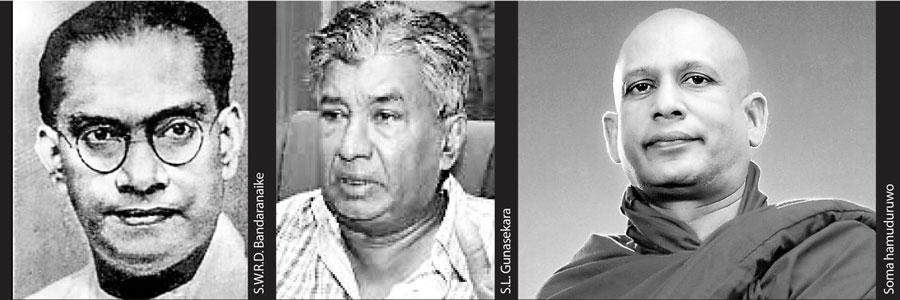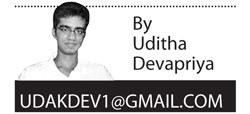Reply To:
Name - Reply Comment

MPs and representatives of the JHU, at least a majority of them, remain more jathika and more the children of 1956 than those of the SLFP
The Hela Urumaya capitalised more than anything else, however, on the grief, anger, and fervour over the passing away of Soma hamuduruwo
 Sinhala Buddhist voters do not take kindly to communal parties, even when those parties represent their interests. The Jathika Hela Urumaya (JHU) remains the most potent and effective Sinhala Buddhist political outfit, but its birth was preceded by several fruitless attempts at coming up with such an organisation.
Sinhala Buddhist voters do not take kindly to communal parties, even when those parties represent their interests. The Jathika Hela Urumaya (JHU) remains the most potent and effective Sinhala Buddhist political outfit, but its birth was preceded by several fruitless attempts at coming up with such an organisation.
The first-ever Sinhala Buddhist party was, of course, S.W.R.D. Bandaranaike’s Sinhala Maha Sabhawa, but if we are to take contemporary politics we have to begin with the Sinhala Bala Mandalaya, formed in 1981 as a front against the Jayewardene regime’s human rights violations. Later attempts included the Mawbima Surakeema Viyaparaya, the Mahajana Eksath Peramuna, the Jathika Sangha Sabhawa, the Sinhala Veera Vidahana and the National Movement Against Terrorism.
The latter was, in one way, the definitive precursor to the Sinhala Urumaya. The Sihala Urumaya was not founded by Athuraliye Rathana Thera and Champika Ranawaka, but they were pivotal in securing much needed votes from the Colombo suburbs. The first face of the Sinhala Urumaya was S.L. Gunasekara. There are so many words one can use to describe Gunasekara. He was frank, he was articulate, he made his point, he said what needed to be said, and he was genuine. He was not a racist.
SL, however, belonged to the old guard. When the Sihala Urumaya contested in 2000, the rift between his cohort and that of Champika Ranawaka became clear: over 75% of the preference votes the party got in the Colombo District went to the latter. When this compelled a confrontation between the two guards and the young rebels warded off SL’s faction, the ousted leader of the party he and his cohorts had helped found came up with a name for his foes: “Talibans.” It must be said that the War on Terror was underway at the time and Ranawaka had called for the government to let the US use our airspace for its fight against Bin Laden.
The first avatar of the Hela Urumaya, the Sihala Urumaya, had an array of colourful, interesting and certainly nationalistic personalities. The first Central Committee had on board Tilak Karunaratne (Secretary), Dr. Neville Karunatilake (Treasurer), Major General Tilak Paranagama, Lieutenant Colonel Anil Amarasekara, Professor Piyasena Dissanayake and Dr. Ranjini Ratnapala (it’s interesting to note that several of these former members are still active in nationalist politics: Amarasekara and Ratnapala, for instance, are spokespersons for the National Joint Committee headed by the likes of Rear Admiral Sarath Weerasekara). Others came to help as well, though none of them was as popular as those canvassing for the UNP, SLFP and other parties. Simply put, the SU did not have the equal of a Vijaya Kumaratunga.
And yet, these people were young and rebellious in spite of their years, fully armed veterans who tolerated no nonsense even from those who they could count as allies: Gunasekara, for instance, is said to have refused to meet with the Mahanayakes or make the usual visit to Dalada Maligawa after the party was founded, an action that cost him dearly when his foes painted a picture of him as an atheist, apathetic leader incapable of mass support. It didn’t help that many of his allies were seen as not being pro-Sinhala Buddhist enough either.
But by no means were the old guard partisan. They were as hostile to neo-liberalism (“with a human face”, as the government liked to call it) as they were to socialism: Neville Karunatilake was described by the party propaganda as a person aware “of the ruination of the country’s economy by the Bandaranaikes’ socialistic policies.” In this they were pandering to a decades-long antipathy of Sinhala Buddhists to what was felt to be the Sirimavo regime’s systematic murder of the Sinhala Buddhist businessman: Malinda Seneviratne echoed these sentiments when he wrote that J.R. Jayewardene’s opening up of the economy completed a process of destruction of local entrepreneurs launched by N.M. Perera, earlier, “in the name of nationalisation.”
Champika Ranawaka was the National Organiser under SL. He targeted the (urban) Sinhala Buddhist who had been disillusioned by the policies of both the UNP and the UPFA, without pandering to Marxist solutions. There they were repeating what S.W.R.D. Bandaranaike tried to do through the SLFP: fashion a party that steered clear of both sides of the political landscape.
However, to compare what transpired in 2000 with what transpired in the 1950s would be akin to comparing apples with oranges. The Left in the 1950s mainly consisted of Communists and Trotskyites, none of whom were as nationalistic or populist as the Left that the Sihala Urumaya had to contend with, the JVP. The LSSP gave rise to N.M. Perera, who contested at a by election in Minneriya and came in second despite denigrating Dutugemunu as a “gadol modaya” at a rally. Nothing of the sort could be expected from the JVP: with its Marxist head and Sinhala heart, it was, then as now, an anachronism, as evidenced by Rohana Wijeweera’s refusal to recognise the LTTE campaign as a liberation struggle (vimukthi aragalaya) and the alignment of the JVP with Mahinda Rajapaksa against the federalist political discourse.
In other words, the odds stacked against a Sinhala Buddhist party that was anti-capitalist, anti-socialist, anti-federalist, and what not were enormous at the time, if at all because there were many other parties and pundits espousing anti-capitalism, anti-socialism, and anti-federalism while being opposed to Sinhala Buddhist supremacy. One of the most virulent critics of Chandrika’s Federal Package and new constitution was Dr. Dayan Jayatilleka, whose antipathy to Ranawaka are known; that he does not mention the JHU for the role they played at the PTOMS demonstrations and Mavil Aru debacle in his extensive study, Long War Cold Peace, tells a lot about his stance, and the stance of many other intellectuals, on the Hela Urumaya.
The closest that a Sinhala Buddhist only party came to winning it was at the 2004 parliamentary elections, when the JHU obtained around six per cent of the votes and nine seats, including two national list seats. By then, the membership of the party had swelled; among its more colourful yet restrained younger members were Ellawala Medhananda Thera and Nishantha Sri Warnasinghe. Again, they were not hacks. They were not amateurs. They were relative newcomers, but that does not mean they lacked experience. They thus soon struck a chord, and not merely in Colombo; when Malinda Seneviratne contested from Jaffnain 2000, he got more votes than the JVP and Nawa Sama Samaja Pakshaya. Buddhists were clearly giving up on Karl Marx.
The Hela Urumaya capitalised more than anything else, however, on the grief, anger, and fervour over the passing away of Soma hamuduruwo. Representations were made, public rallies organised, and statements despatched by party members demanding that grievances of the Buddhist community be resolved. A demand for an inquest on Soma hamuduruwowas also made by the party leadership.
Initially wary of monks coming to politics, the two faces of the Jathika Chinthanaya, Nalin de Silva and Gunadasa Amarasekara, remained conspicuous by their support for the People’s Alliance. But Soma hamuruduwo’s passing away, more than anything, precipitated monks taking to politics; that phenomenon had to be understood in terms of the context of the time. And at that time, it was difficult to not look around and feel wronged by an anti-Buddhist government, “the most anti-Buddhist regime we’ve ever encountered” as Malinda Seneviratne would later describe it.
In the end, Omalpe Sobitha, Ellawala Medananda, Athuraliye Rathana and the lay guard comprising Ranawaka, Warnasinghe and Karunaratne (Udaya Gammanpila came in much later), did their part in organising a full frontal ideological assault on the LTTE. This remains their biggest contribution to the political sphere; whether we like it or not, they conjured up the strongest show of resistance to separatism, despite the full throttle of State propaganda against them and despite the likes of Nalin de Silva and Gunadasa Amarasekara remaining steadfast in their scepticism; “They were born from the ashes of Soma hamuduruwo,” de Silva would once say.
That scepticism is warranted, but only to an extent. The JHU were political creatures. They made use of what was readily available and they came to power. That they had to cohabit with officials and MPs who could hardly be considered as pro-Sinhala Buddhist tells us a lot about the politics of expedience. But the truth remains that the MPs and representatives of the JHU, at least a majority of them, remain more jathika and more the children of 1956 than those of the SLFP – a point Malinda made back when it seemed impossible to attribute such credentials to a third force.